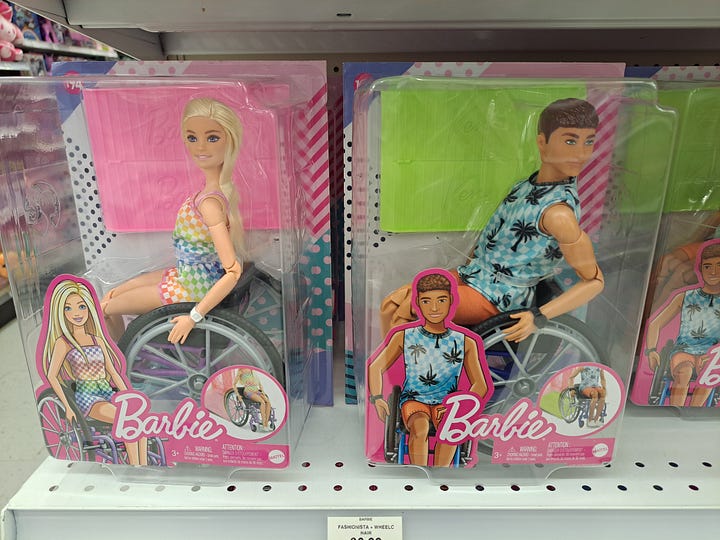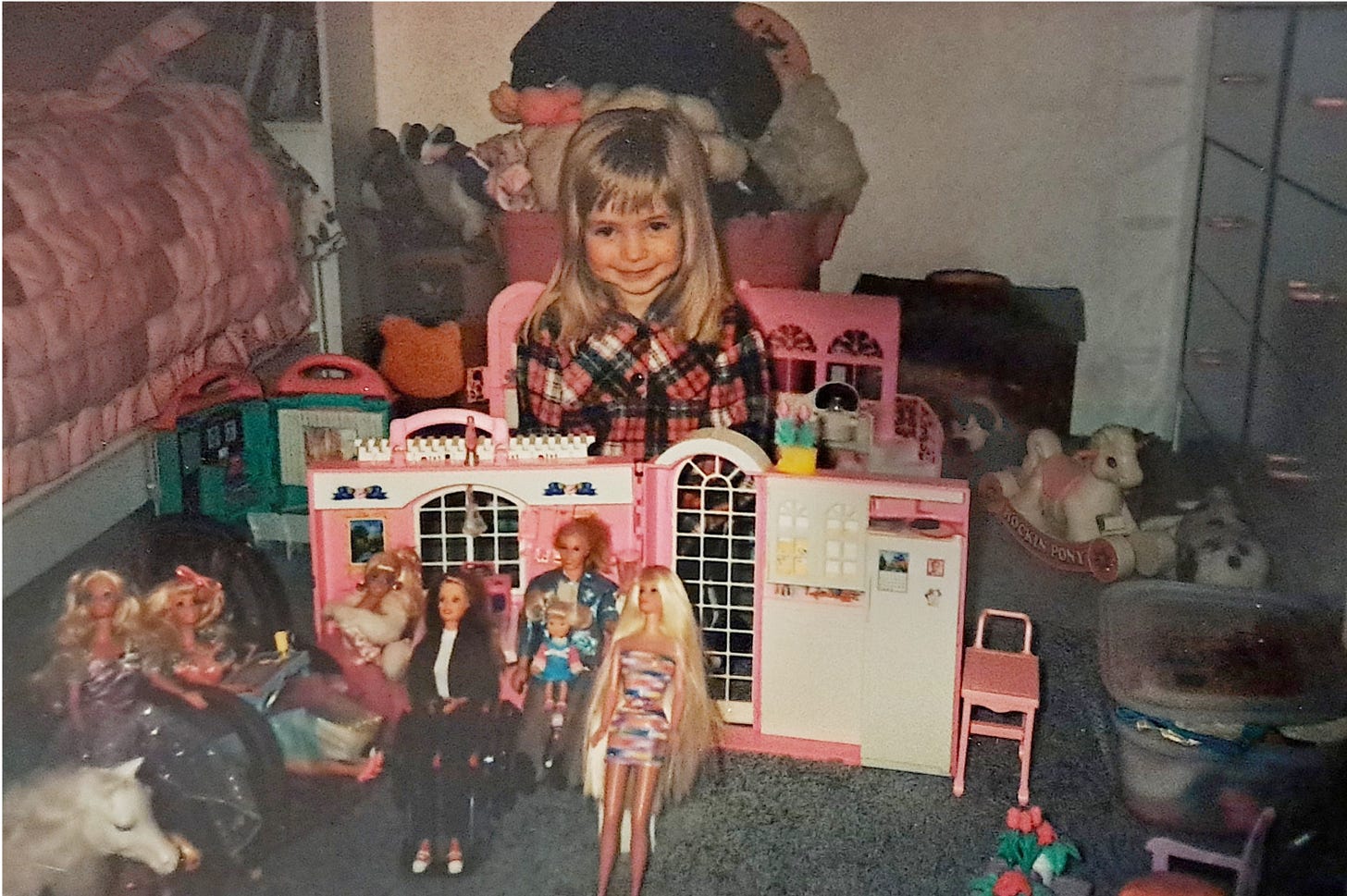What Representation Looks Like When Your Illness is Invisible
The story of Wheelchair Barbie aka Becky
Listen to me read the post above. ⬆️
Notes from a Kindred Spirit is a bi-weekly newsletter about embracing curiosity, exploring hobbies, living with chronic illness, and finding contentment in the everyday.
One Christmas in the early 90s when I was quite young, I made a wishlist for Santa Claus and asked for the one thing I wanted most: Wheelchair Barbie Becky. (Because Barbie was not allowed to be disabled in the 90s, I guess.)
Sadly for me, Santa was not able to find – ahem, make – me a Becky that year. Instead, I got a lovely pink Barbie house that folded out of a case with a carrying handle.
But, the next Christmas, Santa came through! I finally had Becky in my hands and I was ecstatic! She had fiery red hair and a cool leather satchel with a camera. Even her wheelchair was red with glittery wheels!
Needless to say, Becky became a mainstay in the bigger and better Barbie house my parents built for me later. Becky could do anything I wanted her to do. She fell in love, she rode horses, she had kids, she was a hospital patient, she lived in an orphanage, and much more.
Now, you may be wondering why a child who was not a wheelchair user would be so excited about Becky and her wheelchair. There were two reasons for this. One is that my grandfather became a paraplegic before I was born, so as a kid, it made sense to me to have Barbies that mirrored the people I saw in my daily life. The second reason is that I could relate to Wheelchair Becky because she was different from her friends and so was I, even though what made me different wasn’t often visible.
I have an invisible illness but as a kid, there were still times when I felt like it was more visually obvious than I wanted it to be, and that made me stand out as different. Around the age of 5, I had surgery to place a feeding tube in my stomach to help with my nutrition. For the most part, it was easy enough to hide, but I was very self-conscious when wearing tight-fitting clothing like a bathing suit or a leotard in dance class.
There was no Cystic Fibrosis Barbie or Feeding Tube Fiona for me to unwrap at Christmas. So I borrowed representation where I could find it. Wheelchair Becky became my favourite Barbie and I turned my dollhouse into a hospital where the patients became friends, the doctors listened, and everyone got better.
Representation in Barbieland
Mattel has received a lot of criticism over the years (and rightfully so) regarding the lack of representation in its dolls. I was curious about what the Barbie aisle looks like in 2024, so I decided to visit my local toy store.
I’m happy to report that Barbie herself can be a wheelchair user these days. And so can Ken! And Black Barbie too!


And little Chelsea as well.
After I got home, I searched online to see if Mattel has expanded beyond wheelchairs to include other disabilities and they have.1 There is now a version of Barbie in a wheelchair that includes a service dog, both Ken and Barbie with prosthetic legs, two dolls with Downs Syndrome, and introduced just this year, a blind Barbie with a cane.2
While I’m pleased that Mattel is finally making an effort at more inclusivity, it’s a bit disappointing that none of these other dolls were stocked on my local shop’s shelves. Kids with disabilities won’t get to experience the delight of seeing a doll on the store shelves that looks like them and that they can relate to. And parents may be less likely to add to the diversity of their child’s toys if they have to go searching online to find them.
It may be difficult to create a doll to represent something that isn’t visible, but I hope that seeing more and more diversity in their dolls will help kids with invisible illnesses realize that they’re not so different after all.
I was inspired to write this post after watching the Black Barbie documentary on Netflix. I highly recommend it!
More reading
P.S. I have 3 digital products available in the Notion Marketplace!
📚 BOOK CLUB HUB for the book club host who wants to organize their club with ease so they can focus on the fun part—reading good books and chatting about them with friends! It’s perfect for small to medium virtual or in-person clubs.
📖 CURATED BOOK LISTS for the book club host or bookworm who doesn’t know what to read next.
🎁 GIFT PLANNER & TRACKER to help you organize birthday and holiday shopping and stay on budget.









I wish this had been available for you when you were little, but I hope this helps ease your heart a bit.
I'm retired from pediatric nursing and I'm happy to tell you that there is a place to get a stuffed animal with a trach and/or a feeding tube or button, CV line, or O2 tubing. I've sent many parents there over the years.
children can change the stuffed animal's button, fit a feeding tube in there, and so on. they can change the trach ties or the trach of the doll. the dolls are free to children with medical devices. :)
more info here:
https://tubiefriends.com
Perhaps this explains our propensity towards empathy, because we know ourselves that what goes unspoken still matters.